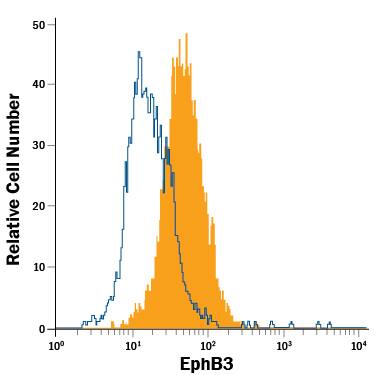Human EphB3 PE-conjugated Antibody
R&D Systems, part of Bio-Techne | Catalog # FAB56671P


Key Product Details
Species Reactivity
Applications
Label
Antibody Source
Product Specifications
Immunogen
Leu38-Ala550
Accession # P54753
Specificity
Clonality
Host
Isotype
Scientific Data Images for Human EphB3 PE-conjugated Antibody
Detection of EphB3 in SH‑SY5Y Human Cell Line by Flow Cytometry.
SH-SY5Y human neuroblastoma cell line was stained with Mouse Anti-Human EphB3 PE-conjugated Monoclonal Antibody (Catalog # FAB56671P, filled histogram) or isotype control antibody (Catalog # IC003P, open histogram). View our protocol for Staining Membrane-associated Proteins.Applications for Human EphB3 PE-conjugated Antibody
Flow Cytometry
Sample: SH‑SY5Y human neuroblastoma cell line
Formulation, Preparation, and Storage
Purification
Formulation
Shipping
Stability & Storage
Background: EphB3
EphB3 (Erythropoietin-producing Hepatocellular Carcinoma-3), also known as Cek10, Tyro6, Sek4, Hek2, and Mdk5, is a 110-130 kDa type I transmembrane glycoprotein member of the Ephrin receptor subfamily, tyrosine protein kinase family of molecules. The Eph proteins have an A and B class that are distinguished by Ephrin ligand binding preference and a common structural organization. Eph-Ephrin interactions are widely involved in the regulation of cell migration, tissue morphogenesis, and inflammation. The 526 amino acid (aa) extracellular domain (ECD) of mature human EphB3 contains a ligand binding domain followed by a cysteine rich region and two fibronectin type III domains. The 418 aa cytoplasmic domain contains a tyrosine kinase domain, a sterile alpha motif (SAM), and a PDZ binding motif. Within the ECD, human EphB3 shares 96% aa sequence identity with mouse and rat EphB3. Binding of EphB3 to its ligands Ephrin-B1, B2, and B3 triggers forward signaling through EphB3 as well as reverse signaling through the Ephrin. EphB3 also interacts in cis with the receptor tyrosine kinase Ryk. Activation of its kinase domain is required for some but not all of the effects of EphB3 on cellular adhesion, motility, and morphology. EphB3 is widely expressed during development and in the adult where it shows a complementary tissue distribution to the Ephrin-B ligands. Cells known to express EphB3 constitutively or inducibly include Langerhans cells, osteoblasts, oligodendroglia, astrocytes, neural stem cell progenitors, cortical thymic epithelium, duodenal Brunner's gland epithelium and gastric parietal cells. EphB3 function is important in vascular, nervous system, thymocyte, and palate development. It directs embyronic neuronal axon pathfinding, and its upregulation on local macrophages following neuronal injury promotes the growth of regenerating axons. Notably, during pancreas development, EphB3 is reportedly a definitive biomarker for fetal islet precursor cells.
Long Name
Alternate Names
Gene Symbol
UniProt
Additional EphB3 Products
Product Documents for Human EphB3 PE-conjugated Antibody
Product Specific Notices for Human EphB3 PE-conjugated Antibody
For research use only